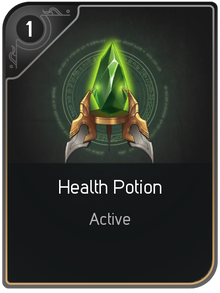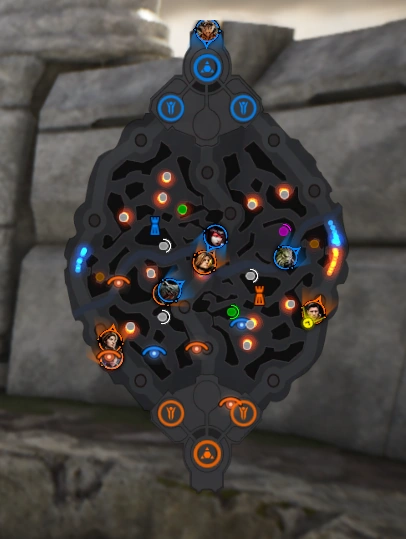This guide was taken from Jamie Shepherd's "A Beginner's Guide to Paragon". Updated 20.01.2017 by tollsunited7
Welcome to Paragon. As you probably already know, Paragon is a MOBA, this is an important distinction right from the start. A lot of players jump into Paragon expecting something more akin to Gears of War, but it's a lot closer to League of Legends or Dota 2 with its implementation of the MOBA genre. This means we have 3 lanes, minions, a jungle, 2 teams of 5 heroes, and a core (nexus/ancient). Paragon plays a lot more strategic than traditional 3rd person games do, so it's important to always remember your positioning in the lane, and where the enemy heroes are at all times.
The Aim of the Game[]
The aim of the game is to kill the enemy's "Core". You achieve this by killing towers, which are strategically lined up along each of the "lanes" in the game. Once the core is dead, the game is over. Everything in-between is the game. Strategic play, quick thinking, communication and positioning will allow you to get kills, allow you to push lanes, and move up the map towards the final objective. Let's start by taking a look at the minimap.
The Minimap[]
To help with keeping track of everything, Paragon gives you a minimap in the top right of your screen. The minimap shows the entire map, and should be your constant point of reference throughout the game. If you're a driver, consider it your rear view mirror. Check it occasionally just to update your brain where everything is, particularly enemy heroes. If an enemy is missing from another lane, they might be on their way to yours, so you might want to reconsider your positioning before you're attacked.
The orange side will always represent the opposing team, with their towers represented as circles. This gives a top-down view of the battlefield. You can also see where friendly and enemy heroes are located, as their portrait is displayed on the minimap, along with the direction they're facing. You (the player) are represented as a yellow circle with an arrow, to help distinguish you from the rest of the minimap.
Minions are much smaller dots, blue for friendly, and orange for enemy minions. There's also 3 inhibitors located just in front of your core, which are important objectives to defend (or destroy). In the center of the map is the jungle, with a myriad of different buffs, paths, and objectives to fight over. These will be explained a little later on. Amber Links are located in the jungle, near the center of the map.
Amber Links[]
Amber Links are an interesting concept somewhat unique to Paragon. They're located around the map, one for each team. Put simply, they are a passively generated source of amber for your team. We'll talk about amber a little later, but it's the currency in Paragon, and therefore very important to accrue as much of it as possible. Amber Links gain Amber every time you or a teammate kills a jungle minion. Every 2 minutes, the Amber Link's contents will be given to the entire team. This amber is not split, the same amount is given to every player on the team.
Amber Links cannot be destroyed, but they can be stolen from, so sometimes it's beneficial for the enemy team to invade one of your areas and steal the Amber from your Amber Link.
Cards[]
Cards are one of Paragon's defining features. If you've played another MOBA, they essentially function as your item shop. If you haven't, they're things you can purchase with all the amber you've built up, and give passive or active boosts to your heroes. For example, a Health Potion when used, restores health to your hero over time. A card like Amp Crystal however, will increase your power and your maximum mana passively. If you fully upgrade this card too, you'll also get a bonus of max mana.

You can bring 40 cards to the battlefield in total, and each of them cost a different amount to play. When you collect amber, your card experience bar increases, and every time you level up, you are gifted a card point to spend in the card shop. The Health Potion from earlier costs 1 card point, whereas the Amp Crystal costs 3 points. You can also play upgrade cards, which essentially make your equipment cards stronger. The Amp Crystal can be upgraded 3 times. Some cards like the Health Potion however can not be upgraded.
You can build your own deck with cards you deem useful for your chosen hero before playing a match. This brings an element of strategy to the game, as each player can have completely unique decks from each other, which contrasts from traditional MOBA item systems in which every player has access to the same items.
Amber[]
Central to all of this is amber. As mentioned earlier, you can get amber from Amber Links, but you can also get it from killing minions, towers, and enemy heroes. At the start of the game it's traditional to have a "laning phase", in which both teams spend part of the early game farming minions. This means killing the little guys, and getting amber from them. If you land the killing blow on a minion, you and teammates nearby get some amber, and the amber flies towards you. This encourages always trying to "last hit" minions, as you increase your amber intake dramatically. It's also worth noting that amber gained from killing minions or neutral creeps is shared between all friendly heroes nearby.
Killing an enemy hero grants a substantial amount of amber, and returns them to their base until they respawn. Killing structures also grants a small amount of amber. Once you have enough amber (also referred to as card XP), you'll level up your card points, so you can purchase more or better cards to play. This is different from leveling up your hero. You can have a maximum of 60 card points to spend in total, so it's important to choose the cards you play wisely. You won't be able to put a 3 cost card in every slot and max it out with 3 cost upgrades.
Hero levels and abilities[]
Killing minions and heroes also grants player experience, which is a separate leveling mechanic altogether. Every player starts at Level 1, and by gaining experience will level up to a maximum level of 15. When leveling up, heroes gain more health, mana, and their base stats become stronger. You also unlock a new ability point on every level up during a match. You can spend this point on any of your 4 abilities (Q, E, R, RMB). Abilities are the core of a hero's kit, and are unique to each hero. Some heroes have abilities which are more offensive centric, often referred to in the game as "carries", whereas some focus more on keeping friendly heroes alive, which is referred to as the term "support". Spending your ability points is important, as it makes your abilities more powerful, and therefore your hero.


